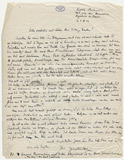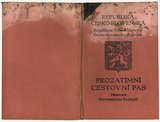The aid organisation HICEM
Und wenn man dann schon alles in Ordnung hat, wer hilft einem weiter? Die HICEM und immer wieder die HICEM!
[And when everything is organised, who will help us then? HICEM, always HICEM! (ed. trans.)]
Anonymous author [“E. St.”] writing about the part played by the aid organisation in his flight from France to the USA, published in the New York German-Jewish newspaper “Aufbau”, March 1941
HICEM was formed in 1927 by amalgamating the Hebrew Sheltering and Immigrant Aid Society (HIAS) in New York, the Jewish Colonization Association (JCA) in Paris and the United Jewish Emigration Committee (EMIGDIRECT) in Berlin. Its international branches provided information about living and working conditions in the destination countries, assisted refugees when communicating with the authorities, and helped finance their emigration. In 1933, HICEM moved its central office from Berlin to Paris and New York. By 1937, they had 57 offices in 21 countries.
HICEM played an important part for people who had been interned and were threatened with deportation, especially after France’s defeat during World War II. It remained the only Jewish aid organisation that was officially recognised by the Vichy regime and was authorised to represent the interests of Jewish refugees when dealing with the French authorities. In June 1942, it was forced to become part of the mandatory organisation “Union Générale des Israélites de France” (General Union of French Jews, UGIF).
The work carried out by the Marseille branch, which remained in existence until 1942, saved the lives of many refugee artists. By no means did they all have the prospect of a U.S. emergency visa, which would have enabled them to get help from the Emergency Rescue Committee (ERC). At times, ship passages could only be booked through HICEM. Moreover, the support offered by HICEM was often the only way in which refugees could pay for their travel documents or ship tickets.
The alliance between the three aid organisations was dissolved at the end of 1945. HIAS still exists today.
Further reading:
Wischnitzer, Mark: Visas to Freedom. The History of HIAS, Cleveland: World Publishing 1956.




